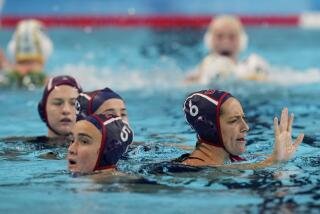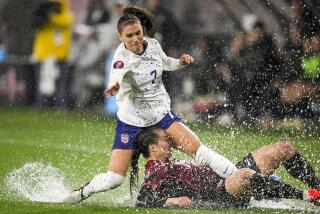Kiwis Simmer Over Call That Negated Victory : America’s Cup: They still believe their boat did not touch buoy marking finish.
- Share via
SAN DIEGO — New Zealand’s sailors, having no recourse to appeal, spent Friday trying to swallow Thursday’s ruling that stripped them of their one-second, come-from-behind victory over Il Moro di Venezia.
But they were seething below the surface. They thought they had won by the length of their bowsprit--itself another bitter story.
The victory could be critical by the end of this nine-race semifinal, which has Il Moro on top at 3-1, New Zealand and France at 2-2 and Nippon at 1-3.
There was thunder Down Under.
Richard Emdean, commodore of the Royal New Zealand Yacht Squadron, asked Peter Montgomery of Radio New Zealand, “What’s going on up there? The people I’ve been meeting with, their mood ranges from fury to bewilderment.”
Apparently, nobody in Auckland had stormed the U.S. embassy--or, more appropriately, the Australian embassy, for it was Graeme Owens, the beleaguered chairman of the Louis Vuitton Cup jury from Perth, who made the call that the Kiwi boat had brushed the inflated buoy that marked one end of the finish line.
That would leave 3 million Kiwis of a single mind: Might have known an Aussie was behind it.
But there was one other possibility: Owens was right.
The racing rules define a boat finishing as the moment when “any part of her hull, or of her crew or equipment in normal position, crosses the finishing line . . . after fulfilling her penalty obligations, if any, under Rule 52.2 (b), Touching a Mark.”
Rule 52.2 (b): “When a yacht touches a finishing mark, she shall not rank as having finished until she first completes her turns and thereafter finishes.”
In other words, the Kiwis were required to go back and finish again. They reckon the umpires told them that about a minute or minute and a half after they thought they had finished.
But the question remains: Did they or didn’t they touch the mark? Members of the crew said emphatically that they didn’t.
Montgomery said he has known most of the principals for years and believed them when “I looked them straight in the eye and asked, ‘Did you hit the mark or not?’ ”
Tactician David Barnes said no. Pitman Denis Kendall said no. Cockpit floater Mark Hauser said no.
TV videos, including shots from a helicopter, are inconclusive. They show the two boats approaching the line on an angle, side by side, with New Zealand barely ahead. About a quarter-boat length from the line, skipper Rod Davis points his boat directly at the line--called “shooting the line”--to cut the distance, bringing the boat closer to the mark.
The mark is bobbing from the boat’s bow wave as it passes. Kendall, prone, reaches over the side to keep a loose line from touching the mark. Farther aft, Hauser runs across the cockpit, bends to look over the side, then straightens up and claps his hands, confident that there was no contact.
“You just can’t create that intuitive reaction,” Montgomery said Friday.
But Hauser was only halfway across the 18-foot-wide boat at the critical moment when the mark may have bobbed and kissed the boat, right on the W in NEW ZEALAND, just behind the widest part of the hull. By the time he looked, it was too late.
The Kiwis said the umpires weren’t in position to make the call, but they might have seen only the umpires’ “wing” boat on the other side of the mark and not a second umpires’ boat behind them.
Owens and Canadian judge Alex Forsyth were in a small runabout about 20 feet astern of the Kiwi boat. They appeared to be in good position to tell whether the boat touched the mark.
“It’s impossible for anyone else to say,” said Bruno Trouble, director of the challengers’ Louis Vuitton Cup media center and a former Cup competitor. “The best positioned people were the judges.”
But there seemed to be some inconsistencies. Owens is said to have told Andrew Johns, the Kiwis’ legal counsel, that he could hear the mark “scraping” the side of the boat.
The Kiwis thought, Montgomery said, “that he must have really wonderful hearing with 10 helicopters above, plus all the boat noises. How could he hear anything?”
If he did hear something, Montgomery suggested, it may have been the winches groaning as the sheets--the lines controlling sail trim--were eased when Davis turned the boat deeper downwind.
New Zealand also said Owens told them that he saw a line dragging over the mark. No part of the boat--lines, sails or crew--is supposed to touch.
But the videos indicate that was not so. When Davis turned downwind, the spinnaker collapsed in toward the mast and its sheet came inboard, away from the mark.
Hauser said, “I came across (the boat) specifically to make sure nothing was trailing. I saw Denis (Kendall) was already doing that. He lifted the lazy brace (line) over the mark. We both watched the mark come past. That’s why I jumped in the air.”
Several of the crew agreed that the mark “never came closer than 18 inches. It was not even close.”
When told they had touched the mark, navigator Mike Quilter snapped a red protest flag onto the backstay--a request for redress. Later, the jury pointed out that “there shall be no appeals, requests for redress, or reopened hearings from decisions made in accordance with (decisions by on-water umpires).”
That’s the rules, case closed, and that’s that. Sorry, mates.


